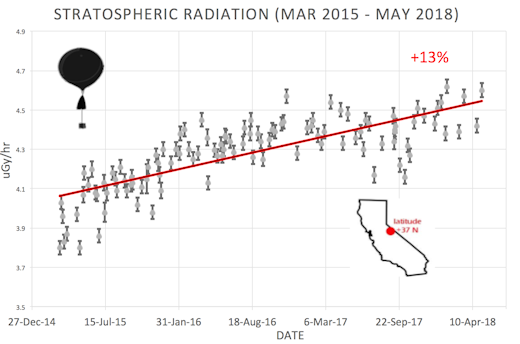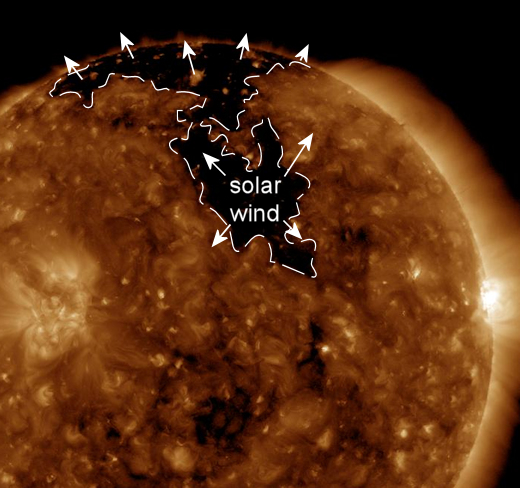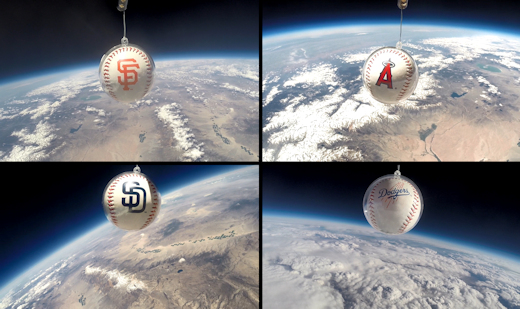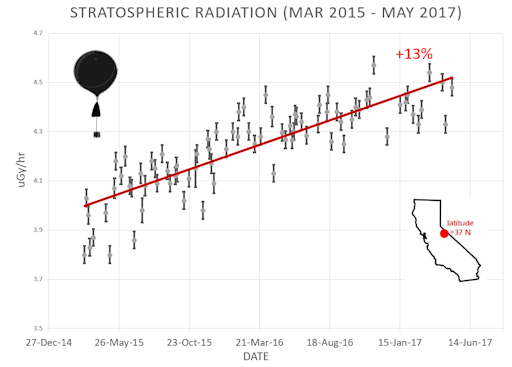All-inclusive Northern Lights trips in Tromsø, Norway. Small groups, big experiences! Highly qualified guides ensure unique and unforgettable adventures with a personal touch. Visit Explore the Arctic | | |
CHINA IS GOING TO THE FARSIDE OF THE MOON: Later this year, China's space agency plans to soft-land a probe on the rugged farside of the Moon. No nation has ever done this before, and it won't be easy. Simply communicating with the lander will be a challenge. This morning, May 21st, China successfully launched a satellite named Queqiao (Chinese for "Magpie Bridge") to relay signals between the lunar farside and Earth. Now preparations can begin to launch the lander itself. Congratulations to China for a big step into the unknown. [full story]
ATMOSPHERIC RADIATION UPDATE: Cosmic rays over California continue to intensify, according to high-altitude balloons launched by Spaceweather.com and the students of Earth to Sky Calculus. We've been monitoring secondary cosmic rays in the stratosphere with regular launches from Bishop CA since 2015. In this data plot, just updated with new measurements from May 2018, we see that 3 of the 4 highest readings occurred just in the past few months:

The worsening cosmic ray situation is linked to the solar cycle. Right now, the sun is heading toward a deep Solar Minimum. As the outward pressure of solar wind decreases, cosmic rays from deep space are able to penetrate the inner solar system with increasing ease. This same phenomenon is happening not only above California, but all over the world.
Take another look at the data plot. The general trend in radiation is increasing, but it is not perfectly linear. From launch to launch we see significant up and down fluctuations. These fluctuations are not measurement errors. Instead, they are caused by natural variations in the pressure and magnetization of the solar wind.
How does the overall increase affect us? Cosmic rays penetrate commercial airlines,
dosing passengers and flight crews enough that pilots are classified as occupational radiation workers by the International Commission on Radiological Protection (ICRP). Some research suggests that cosmic rays can
seed clouds and
trigger lightning, potentially altering weather and climate. Furthermore, there are studies (
#1,
#2,
#3,
#4) linking cosmic rays with cardiac arrhythmias in the general population.
The sensors we send to the stratosphere measure X-rays and gamma-rays, which are produced by the crash of primary cosmic rays into Earth's atmosphere. The energy range of the sensors, 10 keV to 20 MeV, is similar to that of medical X-ray machines and airport security scanners. Stay tuned for updates as the monitoring program continues.
Realtime Space Weather Photo Gallery
SOLAR WIND TO GRAZE EARTH: Minor geomagnetic unrest is possible on May 23rd when a stream of solar wind is expected to graze Earth's magnetic field. The gaseous material is flowing from a hole in the sun's atmosphere, shown here in an extreme ultraviolet image from NASA's Solar Dynamics Observatory:

Because this hole is centered in the sun's northern hemisphere, the emerging stream of solar wind won't hit Earth directly. Instead, it will likely graze our planet's magnetic field--a geometry that can cause the magnetosphere to ring like a bell.
High-latitude sky watchers should be alert for auroras, especially in the southern hemisphere where deepening autumn darkness favors visibility of Southern Lights. Free: Aurora Alerts.
Realtime Aurora Photo Gallery
BASEBALLS IN THE STRATOSPHERE: Father's day is less than a month away. To get ready, the students of Earth to Sky Calculus have been launching baseballs to the edge of space. These unique balls traveled to the stratosphere onboard cosmic ray balloons and returned to Earth ready to be given as far-out gifts to Dad:

You can have one for $129.95. So far we have flown baseballs for the Dodgers, Red Sox, Giants, Angels, and Padres. If your home team is not on that list, let us know and we will fly it for you. Each baseball comes with a greeting card showing the ball in flight and telling the story of its journey to the stratosphere. All sales support atmospheric cosmic ray monitoring and hands-on STEM education.
Far Out Gifts: Earth to Sky Store
All proceeds support hands-on STEM education
Every night, a network of
NASA all-sky cameras scans the skies above the United States for meteoritic fireballs. Automated software maintained by NASA's Meteoroid Environment Office calculates their orbits, velocity, penetration depth in Earth's atmosphere and many other characteristics. Daily results are presented here on Spaceweather.com.
On May. 21, 2018, the network reported 7 fireballs.
(7 sporadics)

In this diagram of the inner solar system, all of the fireball orbits intersect at a single point--Earth. The orbits are color-coded by velocity, from slow (red) to fast (blue). [Larger image] [movies]
Potentially Hazardous Asteroids (
PHAs) are space rocks larger than approximately 100m that can come closer to Earth than 0.05 AU. None of the known PHAs is on a collision course with our planet, although astronomers are finding
new ones all the time.
On May 21, 2018 there were 1907 potentially hazardous asteroids.
 |
Recent & Upcoming Earth-asteroid encounters: | Asteroid | Date(UT) | Miss Distance | Velocity (km/s) | Diameter (m) |
| 2018 JX | 2018-May-16 | 3.9 LD | 13 | 74 |
| 2018 KU | 2018-May-16 | 7.6 LD | 7.8 | 19 |
| 2018 JC | 2018-May-17 | 17.7 LD | 9.3 | 75 |
| 2018 GL1 | 2018-May-18 | 14.3 LD | 5.2 | 69 |
| 2018 KN | 2018-May-19 | 11 LD | 7.5 | 27 |
| 2018 JL2 | 2018-May-19 | 10.9 LD | 13.5 | 40 |
| 2018 KQ | 2018-May-19 | 8.7 LD | 7.7 | 11 |
| 2018 JG1 | 2018-May-20 | 5.3 LD | 8.3 | 45 |
| 2018 KK | 2018-May-21 | 12.1 LD | 9.1 | 32 |
| 2018 KF1 | 2018-May-21 | 2.2 LD | 8.6 | 28 |
| 2018 KS | 2018-May-22 | 2.1 LD | 7.7 | 9 |
| 2018 JK | 2018-May-22 | 16.3 LD | 12.5 | 81 |
| 2018 JG2 | 2018-May-25 | 18.5 LD | 6.9 | 62 |
| 2018 JK3 | 2018-May-27 | 19.6 LD | 21.7 | 173 |
| 2018 KR | 2018-May-28 | 15.7 LD | 4 | 18 |
| 68347 | 2018-May-29 | 9.5 LD | 13.3 | 389 |
| 2013 LE7 | 2018-May-31 | 17.8 LD | 1.7 | 12 |
| 2018 KE1 | 2018-Jun-01 | 10.8 LD | 16.2 | 31 |
| 2018 EJ4 | 2018-Jun-10 | 5.6 LD | 6.2 | 195 |
| 2015 DP155 | 2018-Jun-11 | 9 LD | 4.4 | 170 |
| 2017 YE5 | 2018-Jun-21 | 15.6 LD | 15.5 | 513 |
| 467309 | 2018-Jun-23 | 17.9 LD | 14 | 355 |
| 441987 | 2018-Jun-24 | 7.3 LD | 12.6 | 178 |
Notes: LD means "Lunar Distance." 1 LD = 384,401 km, the distance between Earth and the Moon. 1 LD also equals 0.00256 AU. MAG is the visual magnitude of the asteroid on the date of closest approach. | | Cosmic Rays in the Atmosphere |
Readers, thank you for your patience while we continue to develop this new section of Spaceweather.com. We've been working to streamline our data reduction, allowing us to post results from balloon flights much more rapidly, and we have developed a new data product, shown here:

This plot displays radiation measurements not only in the stratosphere, but also at aviation altitudes. Dose rates are expessed as multiples of sea level. For instance, we see that boarding a plane that flies at 25,000 feet exposes passengers to dose rates ~10x higher than sea level. At 40,000 feet, the multiplier is closer to 50x. These measurements are made by our usual cosmic ray payload as it passes through aviation altitudes en route to the stratosphere over California.
What is this all about? Approximately once a week, Spaceweather.com and the students of Earth to Sky Calculus fly space weather balloons to the stratosphere over California. These balloons are equipped with radiation sensors that detect cosmic rays, a surprisingly "down to Earth" form of space weather. Cosmic rays can seed clouds, trigger lightning, and penetrate commercial airplanes. Furthermore, there are studies ( #1, #2, #3, #4) linking cosmic rays with cardiac arrhythmias and sudden cardiac death in the general population. Our latest measurements show that cosmic rays are intensifying, with an increase of more than 13% since 2015:

Why are cosmic rays intensifying? The main reason is the sun. Solar storm clouds such as coronal mass ejections (CMEs) sweep aside cosmic rays when they pass by Earth. During Solar Maximum, CMEs are abundant and cosmic rays are held at bay. Now, however, the solar cycle is swinging toward Solar Minimum, allowing cosmic rays to return. Another reason could be the weakening of Earth's magnetic field, which helps protect us from deep-space radiation.
The radiation sensors onboard our helium balloons detect X-rays and gamma-rays in the energy range 10 keV to 20 MeV. These energies span the range of medical X-ray machines and airport security scanners.
The data points in the graph above correspond to the peak of the Reneger-Pfotzer maximum, which lies about 67,000 feet above central California. When cosmic rays crash into Earth's atmosphere, they produce a spray of secondary particles that is most intense at the entrance to the stratosphere. Physicists Eric Reneger and Georg Pfotzer discovered the maximum using balloons in the 1930s and it is what we are measuring today.
| | The official U.S. government space weather bureau |
| | The first place to look for information about sundogs, pillars, rainbows and related phenomena. |
| | Researchers call it a "Hubble for the sun." SDO is the most advanced solar observatory ever. |
| | 3D views of the sun from NASA's Solar and Terrestrial Relations Observatory |
| | Realtime and archival images of the Sun from SOHO. |
| | from the NOAA Space Environment Center |
| | fun to read, but should be taken with a grain of salt! Forecasts looking ahead more than a few days are often wrong. |
| | from the NOAA Space Environment Center |
| | the underlying science of space weather |
 | Reviews here can help you to pick up best memory foam mattresses. |
| | These links help Spaceweather.com stay online. Thank you to our supporters! |
| | | | | | |

